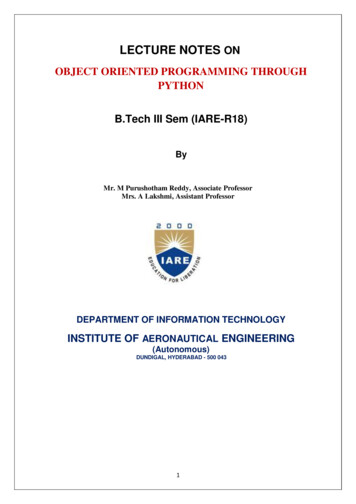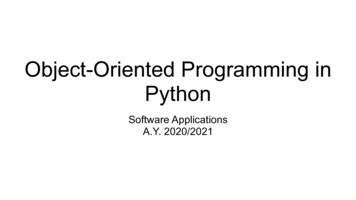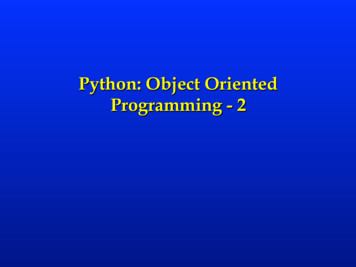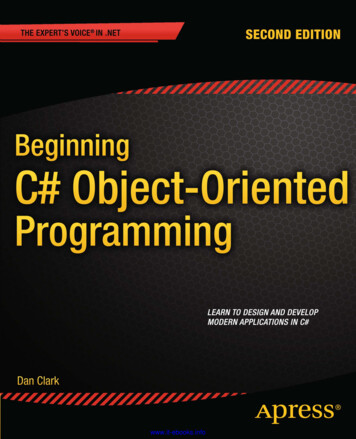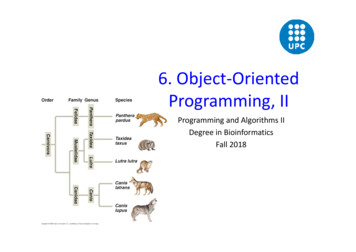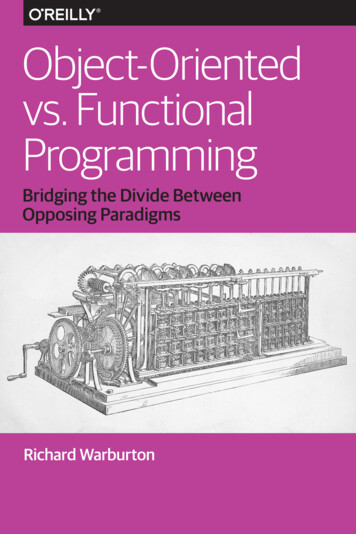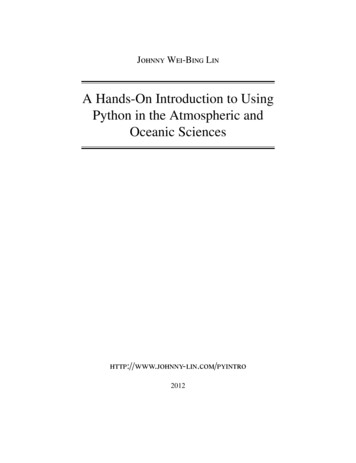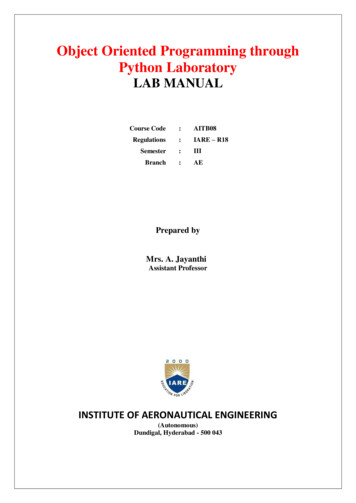
Transcription
Object Oriented Programming throughPython LaboratoryLAB MANUALCourse Code:AITB08Regulations:IARE – R18Semester:IIIBranch:AEPrepared byMrs. A. JayanthiAssistant ProfessorINSTITUTE OF AERONAUTICAL ENGINEERING(Autonomous)Dundigal, Hyderabad - 500 043
INSTITUTE OF AERONAUTICAL ENGINEERING(Autonomous)Dundigal, Hyderabad – 500043Program OutcomesPO1Engineering knowledge: Apply the knowledge of mathematics, science, engineeringfundamentals, and an engineering specialization to the solution of complex engineering problems.PO2 Problem analysis: Identify, formulate, review research literature, and analyze complexengineering problems reaching substantiated conclusions using first principles of mathematics,natural sciences, and engineering sciences.PO3 Design/development of solutions: Design solutions for complex engineering problems and designsystem components or processes that meet the specified needs with appropriate consideration forthe public health and safety, and the cultural, societal, and environmental considerations.PO4 Conduct investigations of complex problems: Use research-based knowledge and researchmethods including design of experiments, analysis and interpretation of data, and synthesis of theinformation to provide valid conclusions.PO5 Modern tool usage: Create, select, and apply appropriate techniques, resources, and modernengineering and IT tools including prediction and modeling to complex engineering activities withan understanding of the limitations.PO6 The engineer and society: Apply reasoning informed by the contextual knowledge to assesssocietal, health, safety, legal and cultural issues and the consequent responsibilities relevant to theprofessional engineering practice.PO7 Environment and sustainability: Understand the impact of the professional engineering solutionsin societal and environmental contexts, and demonstrate the knowledge of, and need forsustainable development.PO8 Ethics: Apply ethical principles and commit to professional ethics and responsibilities and normsof the engineering practice.PO9 Individual and team work: Function effectively as an individual, and as a member or leader indiverse teams, and in multidisciplinary settings.PO10 Communication: Communicate effectively on complex engineering activities with theengineering community and with society at large, such as, being able to comprehend and writeeffective reports and design documentation, make effective presentations, and give and receiveclear instructions.PO11 Project management and finance: Demonstrate knowledge and understanding of the engineeringand management principles and apply these to one’s own work, as a member and leader in a team,to manage projects and in multidisciplinary environments.PO12 Life-long learning: Recognize the need for, and have the preparation and ability to engage inindependent and life-long learning in the broadest context of technological change.Program Specific Outcomes (AE)PSO1 Professional Skills: Able to utilize the knowledge of aeronautical/aerospace engineering ininnovative, dynamic and challenging environment for design and development of new products.PSO2 Professional skills: Imparted through simulation language skills and general purpose CAEpackages to solve practical, design and analysis problems of components to complete the challengeof airworthiness for flight vehicles.PSO3 Practical implementation and testing skills: Providing different types of in house and trainingand industry practice to fabricate and test and develop the products with more innovativetechnologies.PSO4 Successful Career and Entrepreneurship: To prepare the students with broad aerospaceknowledge to design and develop systems and subsystems of aerospace and allied systems andbecome technocrats.
INSTITUTE OF AERONAUTICAL ENGINEERING(Autonomous)Dundigal, Hyderabad – 500043ATTAINMENT OF PROGRAM OUTCOMES& PROGRAM SPECIFIC OUTCOMESS NoExperimentProgram OutcomeAttainedProgram SpecificOutcomes Attained1BASICS OF PYTHONPO1, PO2, PO3PSO1, PSO22CONTROL FLOWPO1, PO2, PO3PSO1, PSO23STRINGSPO1, PO2, PO3PSO1, PSO24LISTPO2, PO3PSO1, PSO25MULTI DIMENSIONAL LISTPO3, PO4PSO1, PSO26CLASSPO2, PO3PSO1, PSO27METHODSPO2, PO3PSO1, PSO28CONSTRUCTORSPO2, PO3PSO1, PSO29INHERITANCEPO3, PO4PSO1, PSO210POLYMORPHISMPO3, PO4PSO1, PSO211OVERRIDING MAGIC METHODSPO2, PO3PSO1, PSO212EVENT-DRIVEN PROGRAMMINGPO2, PO3PSO1, PSO2
INSTITUTE OF AERONAUTICAL ENGINEERING(Autonomous)Dundigal, Hyderabad - 500 043CertificateThis is to Certify that it is a bonafied record of Practical work doneby Sri/Kum.the Roll No.bearingofClassBranch in thelaboratory during the Academicyearunder our supervision.Head of the DepartmentLecture In-ChargeExternal ExaminerInternal Examiner4 Page
DATA STRUCTURES LABORATORYIII Semester: AECourse CodeCategoryAITB08CoreContact Classes: NilTutorial Classes: NilHours / WeekLTP102CreditsC2Practical Classes: 36Maximum MarksCIASEETotal3070100Total Classes: 36COURSE OBJECTIVES:The course should enable the students to:I. Learn adequate knowledge to write, test, and debug simple Python programsII. Understand programming skills using the fundamentals and basics of Python Language.III. Improve problem solving skills using strings, and functions.IV. Understand the compound data using Python lists, class, methods.V. Understand the concepts of inheritance, polymorphism and overriding.LIST OF EXPERIMENTSWeek-1BASICS OF PYTHONWrite Python programs for the following:a. Purposefully raise Indentation Error and Correct it.b. Compute distance between two points taking input from the user (Pythagorean Theorem).c. To takes numbers as command line arguments and print its sum.Week-2CONTROL FLOWWrite Python programs for implementing the following:a. Checking whether the given number is even number or not.b. Finding the factorial of a number.c. Print the prime numbers below 100.Week-3STRINGSWrite Python programs for implementing the following:a. Count the numbers of characters in the string and store them in a dictionary data structureb. Using split and joins methods in the string and trace a birthday with a dictionary data structure.Week-4LISTWrite Python programs to for the following:a. Finding mean, median, mode for the given set of numbers in a list.b. Function dups to find all duplicates in the list.Week-5MULTI DIMENSIONAL LISTWrite Python programs for the following:a. Addition of two square matrices.b. Multiplication of two matrices.Week-6IMPLEMENTATION OF SINGLE LINKED LISTWrite Python programs to implement the following:a. Find the validity of a string of parentheses, '(', ')', '{', '}', '[' and ']. These brackets must be close in thecorrect order, for example "()" and "()[]{}" are valid but "[)", "({[)]" and "{{{" are invalid.b. Get all possible unique subsets from a set of distinct integers.5 Page
Week-7METHODSWrite Python programs to do the followinga. Create a Python class named Circle constructed by a radius and two methods which will compute the areaand the perimeter of a circle.b. Create a Python class named Rectangle constructed by a length and width and a method which willcompute the area of a rectangle.Week-8CONSTRUCTORSWrite Python program to implement constructors.Week-9INHERITANCEWrite Python program to implement inheritance.Week-10POLYMORPHISMWrite Python program to implement Polymorphism.Week-11OVERRIDING MAGIC METHODSWrite Python program to override Magic Methods.Week-12EVENT-DRIVEN PROGRAMMINGWrite Python program to create a simple calculator, where the user will enter a number in a text field, andeither add it to or subtract it from a running total, which we will display. We will also allow the user to resetthe total.Text Books:1. R Nageswara Rao, “Core Python Programming”, Dreamtech press, 2017 Edition.2. Dusty Philips, “Python 3 Object Oriented Programming”, PACKT Publishing, 2 nd Edition, 2015.Reference Books:1. Rance D. Necaise, “Object-Oriented Programming in Python Documentation Release 1”, University ofCape Town and individual contributors, 2017.Web References:1. exercises/2. ntals-part-2/python-object-orientedprogramming- exercises6 Page
WEEK - 1BASICS OF PYTHONOBJECTIVE:a. To purposefully raise Indentation Error and Correct it.b. To compute distance between two points taking input from the user (Pythagorean Theorem).c. To take numbers as command line arguments and print its sum.RESOURCE:Python 3.7.3PROGRAM LOGIC:Compute distance between two points:1. Read number of terms.2. Send values to mathematical sqrt function3. Print the distanceSum of two numbers:1. Read two integers n1 and n2.2. Use arithmetic operator 3. Print the sum.PROCEDURE:a. Create : Open a new file in Python shell, write a program and save the program with .py extension.b. Execute : Go to Run - Run module (F5)SOURCE CODE:Script to purposefully raise Indentation Error and Correct derabad") IndentationError: unexpected derabadCompute distance between two pointsimport mathp11 int(input())p12 int(input())p21 int(input())p22 int(input())distance math.sqrt( ((p11-p21)**2) ((p12-p22)**2) )print(distance)Input:7 Page
0466Output:6.324555320336759Sum of two numbersimport sysa, b sys.argv[1:2]summ int(a) int(b)print("sum is", summ)Input:23Output:sum is 5PRE LAB VIVA QUESTIONS:a. What is indent in python?b. What are the three basic data types we have in python?c. Explain the syntax for comment a statement?POST LAB VIVA QUESTIONS:a. What do you understand indentation in python?b. Which file has to include to use sqrt method?c. Explain about python language?8 Page
WEEK - 2CONTROL FLOWOBJECTIVES:a. To checking whether the given number is even number or not.b. To find the factorial of a number.c. To print the prime numbers below 100RESOURCE:Python 3.7.3PROGRAM LOGIC:Checking whether the given number is even number or not1. Read the number.2. Divide the number by 23. Compare the reminder value4. Display the resultFinding the factorial of a number1. Read the number.2. Decrement the value3. Compare the reminder value4. Display the resultPrint the prime numbers below 1001. Read the number.2. Check the number prime or not3. If yes print the number4. If not decrement the value5. Check the number reaches zero.6. If not goto step27. End of the program.PROCEDURE:a. Create : Open a new file in Python shell, write a program and save the program with .py extension.b. Execute : Go to Run - Run module (F5)SOURCE CODE:Checking whether the given number is even number or nota int(input())if(a%2 n9 Page
Finding the factorial of a numbera int(input())k 1;for i in range(1,a 1):k k*i;print("The factorial of given number is", k)input:5Output:The factorial of given number is 120Print the prime numbers below 100for i in range(2,100):c 0;for j in range(1,i 1):if(i%j 0):c c 1if(c 2):print(i,end " "),Output:2 3 5 7 11 13 17 19 23 29 31 37 41 43 47 53 59 61 67 71 73 79 83 89 97PRE LAB VIVA QUESTIONS:a. Define loop process?b. How many loops are there?c. Explain the syntax of for loop?POST LAB VIVA QUESTIONS:a. What do you understand by loop?b. Explain the nested control statements?c. Differentiate between for loop and while loopd. On which data types only for loop applicable10 P a g e
WEEK - 3STRINGSOBJECTIVES:a. To implement to count the numbers of characters in the string and store them in a dictionary datastructureb. To use split and joins methods in the string and trace a birthday with a dictionary data structureRESOURCE:Python 3.7.3PROGRAM LOGIC:Count the numbers of characters in the string1. Read the string.2. Count the characters3. Display the resultPROCEDURE:a. Create : Open a new file in Python shell, write a program and save the program with .py extension.b. Execute : Go to Run - Run module (F5)SOURCE CODE:Count the numbers of characters in the stringstr1 input()dict {}for n in str1:keys dict.keys()if n in keys:dict[n] 1else:dict[n] 1print(dict)Input:SuccessOutput:{'s': 3, 'u': 1, 'c': 2, 'e': 1}Split and joins methods in the stringbirthdays {'Alice': 'Apr 1 1998', 'Bob': 'Dec 12,2001', 'Carol': 'Mar 4,2002'}name input()if name in birthdays:s birthdays[name];L s.split(" ")k "-"L k.join(L)print(L ' is the birthday of ' name)else:print('I do not have birthday information for ' name)11 P a g e
Input:AliceOutput:Apr-1-1998 is the birthday of AlicePRE LAB VIVA QUESTIONS:a. Define the syntax of dictionary?b. What is the difference between List and Dictionary?c. Explain the syntax of List slicing?POST LAB VIVA QUESTIONS:a. What are the various methods used on list objects?b. Explain the purpose of dictionary?c. Parameters used in get() of dictionary variabled. Explain different ways to display dictionary elements12 P a g e
WEEK - 4LISTOBJECTIVES:a. To finding mean, median, mode for the given set of numbers in a list.b. To function dups to find all duplicates in the list.RESOURCE:Python 3.7.3PROGRAM LOGIC:To find mean, median, mode for the given set of numbers in a list.1. Read the elements into a list.2. Calculate the sum of list elements.3. Calculate the mean, median.4. Display the result.Function dups to find all duplicates in the list.1.2.3.4.5.Create a list to read elements.Pass the list as parameter to dup function.Define function dup to identify duplicate elements in the list.Return the final list to called function.Display the result.PROCEDURE:a. Create : Open a new file in Python shell, write a program and save the program with .py extension.b. Execute : Go to Run - Run module (F5)SOURCE CODE:To find mean, median, mode for the given set of numbers in a listfrom collections import Countern num [1, 2, 3, 4, 5,5]n len(n num)get sum sum(n num)mean get sum / nnnum n num;print("Mean / Average is: " str(mean))nnum.sort()if n % 2 0:median1 nnum[n//2]median2 nnum[n//2 - 1]median (median1 median2)/2else:median nnum[n//2]print("Median is: " str(median))data Counter(n num)get mode dict(data)mode [k for k, v in get mode.items() if v max(list(data.values()))]if len(mode) n:get mode "No mode found"13 P a g e
else:get mode "Mode is / are: " ', '.join(map(str, mode))print(get mode)Output:Mean / Average is: 3.3333333333333335Median is: 3.5Mode is / are: 5Function dups to find all duplicates in the list.def Remove(duplicate):final list []for num in duplicate:if num not in final list:final list.append(num)return final list# Driver Codeduplicate [2, 4, 10, 20, 5, 2, 20, 4]print(Remove(duplicate))Output:[2, 4, 10, 20, 5]PRE LAB VIVA QUESTIONS:a. Define the syntax of function definition?b. What is a parameter?c. Explain the empty List()POST LAB VIVA QUESTIONS:a. What are the various methods used on list objects?b. Explain the purpose of function?c. How we pass list to a functiond. Differentiate between list and dictionary14 P a g e
WEEK - 5MULTI DIMENSIONAL LISTOBJECTIVES:a. Write a Python script for addition of two square matrices.b. Write a Python script for multiplication of two matrices.RESOURCE:Python 3.7.3PROGRAM LOGIC:Addition of two square matrices.1. Create a lists to read matrix elements2. Read the elements of to matrices add the elements3. Store the result in third matrix.4. Repeat steps 2 and 3 till the addition of all elements5. Display the resultMultiplication of two matrices1. Create a lists to read matrix elements2. Read the elements of to matrices, multiply the elements3. Store the result in third matrix.4. Repeat steps 2 and 3 till the multiplication of all elements5. Display the result.PROCEDURE:a. Create : Open a new file in Python shell, write a program and save the program with .py extension.b. Execute : Go to Run - Run module (F5)SOURCE CODE:Addition of two square matricesX [[12,7,3],[4 ,5,6],[7 ,8,9]]Y [[5,8,1],[6,7,3],[4,5,9]]result [[0,0,0],[0,0,0],[0,0,0]]# iterate through rowsfor i in range(len(X)):# iterate through columnsfor j in range(len(X[0])):result[i][j] X[i][j] Y[i][j]for r in result:print(r)Output:[17, 15, 4][10, 12, 9][11, 13, 18]15 P a g e
Multiplication of two matricesX [[12,7,3],[4 ,5,6],[7 ,8,9]]# 3x4 matrixY [[5,8,1,2],[6,7,3,0],[4,5,9,1]]# result is 3x4result [[0,0,0,0],[0,0,0,0],[0,0,0,0]]# iterate through rows of Xfor i in range(len(X)):# iterate through columns of Yfor j in range(len(Y[0])):# iterate through rows of Yfor k in range(len(Y)):result[i][j] X[i][k] * Y[k][j]for r in result:print(r)Output:[114, 160, 60, 27][74, 97, 73, 14][119, 157, 112, 23]PRE LAB VIVA QUESTIONS:a. Define the multidimensional list?b. What is a parameter?c. Explain the various methods of List objectPOST LAB VIVA QUESTIONS:a. What is difference between List and tuple?b. Explain the range function?c. Explain various arguments used in range functiond. Explain the slicing list elements16 P a g e
WEEK-6CLASSOBJECTIVES:a. Find the validity of a string of parentheses, '(', ')', '{', '}', '[' and ']. These brackets must be close in thecorrect order, for example "()" and "()[]{}" are valid but "[)", "({[)]" and "{{{" are invalid.b. Get all possible unique subsets from a set of distinct integers.RESOURCE:Python 3.7.3PROGRAM LOGIC:Validity of a string of parentheses1. Create a lists to read string of parentheses2. Read the open,close parentheses into two lists3. Compare the open and close list parentheses.4. Display the resultPROCEDURE:a. Create : Open a new file in Python shell, write a program and save the program with .py extension.b. Execute : Go to Run - Run module (F5)SOURCE CODE:open list ["[","{","("]close list ["]","}",")"]def check(myStr):stack []for i in myStr:if i in open list:stack.append(i)elif i in close list:pos close list.index(i)if ((len(stack) 0) and(open list[pos] stack[len(stack)-1])):stack.pop()else:return "Unbalanced"if len(stack) 0:return "Balanced"string "{[]{()}}"print(string,"-", check(string))string "[{}{})(]"print(string,"-", check(string))Output:{[]{()}} - Balanced[{}{})(] - UnbalancedGet all possible unique subsets from a set of distinct integers.class py solution:17 P a g e
def sub sets(self, sset):return self.subsetsRecur([], sorted(sset))def subsetsRecur(self, current, sset):if sset:return self.subsetsRecur(current, sset[1:]) self.subsetsRecur(current [sset[0]], sset[1:])return [current]print(py solution().sub sets([4,5,6]))Output:[[], [6], [5], [5, 6], [4], [4, 6], [4, 5], [4, 5, 6]]PRE LAB VIVA QUESTIONS:a. Define the class?b. What is an object?POST LAB VIVA QUESTIONS:a. What is stack?b. Explain the recursion function?c. Which constructor used to create empty list?d. Explain the stack operations?e. What are the linear data structures?18 P a g e
WEEK - 7METHODSOBJECTIVE:a. Create a Python class named Circle constructed by a radius and two methods which will compute thearea and the perimeter of a circle.b. Create a Python class named Rectangle constructed by a length and width and a method which willcompute the area of a rectangle.RESOURCE:Python 3.7.3PROGRAM LOGIC:Validity of a string of parentheses1. Create a class circle2. Define a method to calculate radius3. Create object to call the methods of class4. Display the resultPROCEDURE:a. Create : Open a new file in Python shell, write a program and save the program with .py extension.b. Execute : Go to Run - Run module (F5)SOURCE CODE:The area and the perimeter of a circle.class Circle():def init (self, r):self.radius rdef area(self):return self.radius**2*3.14def perimeter(self):return 2*self.radius*3.14NewCircle rimeter())Output:200.9650.24The area of a rectangle.class Rectangle():def init (self, l, w):self.length lself.width wdef rectangle area(self):return self.length*self.widthnewRectangle Rectangle(12, 10)print(newRectangle.rectangle area())Output:12019 P a g e
PRE LAB VIVA QUESTIONS:a. How we create object to a class?b. How we call the method of a class?POST LAB VIVA QUESTIONS:a. What is instance of a class?b. Write the syntax to create a list object?c. Write the syntax for creation of empty list?20 P a g e
WEEK - 8CONSTRUCTORSOBJECTIVE:Write Python program to implement constructors.RESOURCE:Python 3.7.3SOURCE CODE:class IARE:geek ""def init (self):self.geek "IARE"def print Geek(self):print(self.geek)obj IARE()obj.print Geek()Output:IAREPRE LAB VIVA QUESTIONS:a. What is a constructor?b. When constructor is executed?POST LAB VIVA QUESTIONS:a. What is the use of constructor?b. When constructor is executed?c. Which constructor executes when creating a list object?21 P a g e
WEEK - 9INHERITANCEOBJECTIVE:Write Python program to implement inheritanceRESOURCE:Python 3.7.3SOURCE CODE:class Person(object):def init (self, name):self.name namedef getName(self):return self.namedef isEmployee(self):return Falseclass Employee(Person):def isEmployee(self):return Trueemp Person("IARE1")print(emp.getName(), emp.isEmployee())emp Employee("IARE2")print(emp.getName(), emp.isEmployee())Output:IARE1 FalseIARE2 TruePRE LAB VIVA QUESTIONS:a. What is a inheritance?b. Multiple inheritance means what?POST LAB VIVA QUESTIONS:a. What is the use of inheritance?b. Explain the multiple inheritances?c. Explain polymorphism?22 P a g e
WEEK - 10POLYMORPHISMOBJECTIVE:Write Python program to implement Polymorphism.RESOURCE:Python 3.7.3PROGRAM LOGIC:PROCEDURE:a. Create : Open a new file in Python shell, write a program and save the program with .py extension.b. Execute : Go to Run - Run module (F5)SOURCE CODE:def add(x, y, z 0):return x y zprint(add(2, 3))print(add(2, 3, 4))Output:53PRE LAB VIVA QUESTIONS:a. What is polymorphism?b. Explain object oriented features?c. Explain the importance of polymorphism?POST LAB VIVA QUESTIONS:a. What is the use of polymorphism?b. Differentiate between inheritance and polymorphism?c. How we implements polymorphism in python?23 P a g e
WEEK - 11OVERRIDING MAGIC METHODSOBJECTIVE:Write Python program to override Magic Methods.RESOURCE:Python 3.7.3PROGRAM LOGIC:PROCEDURE:a. Create : Open a new file in Python shell, write a program and save the program with .py extension.b. Execute : Go to Run - Run module (F5)SOURCE CODE:class Bird:def intro(self):print("There are many types of birds.")def flight(self):print("Most of the birds can fly but some cannot.")class sparrow(Bird):def flight(self):print("Sparrows can fly.")class ostrich(Bird):def flight(self):print("Ostriches cannot fly.")obj bird Bird()obj spr sparrow()obj ost ostrich()obj bird.intro()obj bird.flight()obj spr.intro()obj spr.flight()obj ost.intro()obj ost.flight()Output:New Delhi is the capital of India.Hindi the primary language of India.India is a developing country.Washington, D.C. is the capital of USA.English is the primary language of USA.USA is a developed country.PRE LAB VIVA QUESTIONS:a. What is method over loading?b. Explain method overriding?c. Explain the importance method overloading?POST LAB VIVA QUESTIONS:a. How compiler knows which function has to execute at the time of method over loading?b. Explain the various parameters used in function calling?c. Differentiate between function calling by reference and call by value24 P a g e
WEEK - 12EVENT-DRIVEN PROGRAMMINGOBJECTIVE:Write Python program to create a simple calculator, where the user will enter a number in a text field,and either add it to or subtract it from a running total, which we will display. We will also allow the user toreset the total.RESOURCE:Python 3.7.3PROCEDURE:a. Create : Open a new file in Python shell, write a program and save the program with .py extension.b. Execute : Go to Run - Run module (F5)SOURCE CODE:def add(x, y):return x ydef subtract(x, y):return x - ydef multiply(x, y):return x * ydef divide(x, y):return x / yprint("Select ("3.Multiply")print("4.Divide")choice input("Enter choice(1/2/3/4):")num1 int(input("Enter first number: "))num2 int(input("Enter second number: "))if choice '1':print(num1," ",num2," ", add(num1,num2))elif choice '2':print(num1,"-",num2," ", subtract(num1,num2))elif choice '3':print(num1,"*",num2," ", multiply(num1,num2))elif choice '4':print(num1,"/",num2," ", divide(num1,num2))else:print("Invalid input")Input and Output:Select operation.1.Add2.Subtract3.Multiply4.DivideEnter choice(1/2/3/4):1Enter first number: 3Enter second number: 43 4 725 P a g e
PRE LAB VIVA QUESTIONS:a. What is the predefined function required?b. Which file we are importing to execute?c. Explain the importance function declaration?POST LAB VIVA QUESTIONS:a. Explain the object creation in python?b. Explain the exception handling?c. Explain try catch in python?26 P a g e
R Nageswara Rao, “Core Python Programming”, Dreamtech press, 2017 Edition. 2. Dusty Philips, “Python 3 Object Oriented Programming”, PACKT Publishing, 2 nd Edition, 2015. Reference Books: 1. Rance D. Necaise, “Object-Oriented Programming in Python Documentation Release 1”, U
